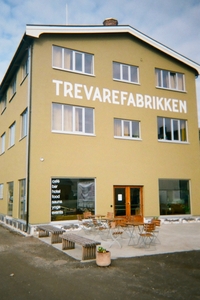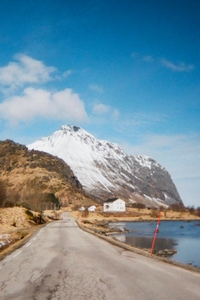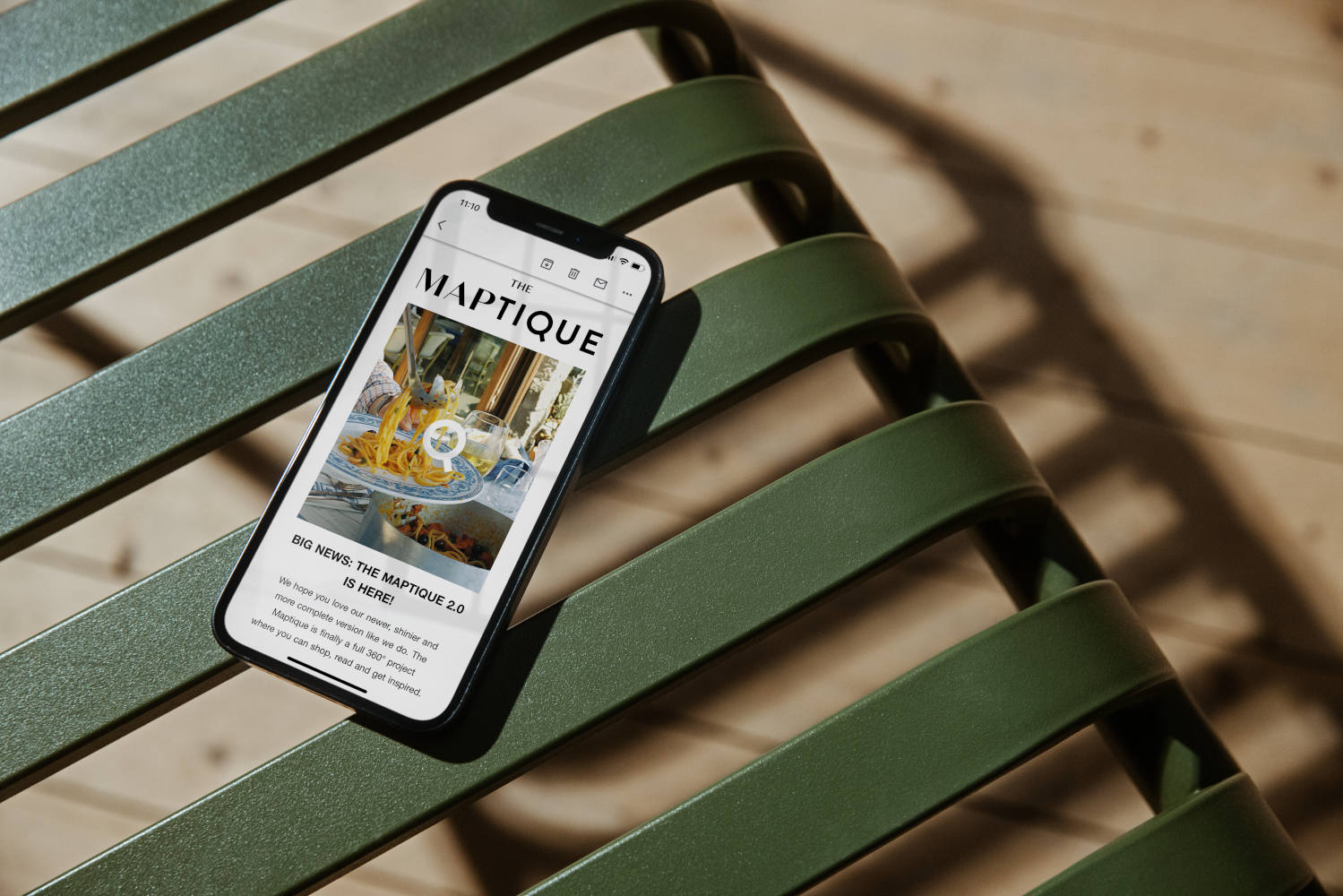
Lofoten
Norway
The Lofoten Islands aren’t just a destination—they’re a full-body experience. Perched above the Arctic Circle in northern Norway, this string of islands stuns with dramatic peaks, tiny fishing villages, and roads that weave between sea and sky. It’s wild, remote, and surprisingly alive—with Arctic surf, cozy bakeries, and golden light that lasts all night in summer.
Here, everything feels sharper, deeper, more vivid. The air is crisp with salt and woodsmoke; the silence hums. One moment, you're kayaking under towering cliffs, the next you're barefoot on a white-sand beach with nothing but wind and waves. Cafés serve cardamom buns warm from the oven; saunas glow beside freezing fjords. In Lofoten, time stretches and moods shift—between stillness and adventure, rugged and refined. You don’t just see this place. You feel it in your chest, like a story you somehow already know.
Curation, Editing & Photos: Rebecca Leporati

Svolvær
Your journey begins in Evenes, one of the most accessible gateways to the Lofoten Islands. Unlike smaller airports across the archipelago—often served only by limited flights—Evenes is well-connected to Oslo and ideal for starting a road trip. The drive to the heart of Lofoten takes around three hours and is a visual feast: winding roads along deep fjords, sharp peaks, and scattered red cabins. It's the perfect way to ease into the poetic beauty of Northern Norway.
Your first real stop is Svolvær, often called the “capital” of Lofoten. More than a postcard village, it offers a glimpse into everyday life above the Arctic Circle—with schools, homes, and a key commercial port. Many sea excursions start here. From here, take a boat tour to Trollfjord, one of Lofoten’s most dramatic fjords. Choose an adrenaline-filled RIB adventure with XX Lofoten, or a peaceful electric cruise with Brim Explorer. Steep cliffs rise around you; sea eagles often soar overhead. Have extra time? Take a short detour to Skrova, a small, untouched island nearby. It’s ideal for sea kayaking—glide through turquoise waters and along rocky shores with the Arctic sun above. Skrova Kayak can tailor the experience just for you.




Henningsvær
After leaving Svolvær, it won’t take long before you find yourself in one of Lofoten’s most magnetic villages: Henningsvær. Less than 30 minutes away, the road alone feels cinematic—hugging fjords, skimming past dramatic peaks, over bridges floating on icy turquoise water. Once a quiet fishing village, Henningsvær is now a creative hub where climbers, artists, chefs, and musicians cross paths. Its streets hum with curated vintage shops, cozy cafés, open studios, and a laid-back energy that makes people stay longer than planned. Check in at Trevarefabrikken, a former cod factory turned design-forward guesthouse. Industrial and warm, it blends Nordic simplicity with creative spirit. Upstairs: minimalist, stylish rooms. Downstairs: a lively café, restaurant, and what might be the best cardamom bun you’ll ever try. Events, concerts, and vintage markets fill the space year-round. Don’t miss their iconic seaside sauna—a glass-fronted retreat where you can plunge into Arctic waters and warm back up while watching eagles, orcas, and shifting light play across the fjord.
After check-in, ease into town. First stop: Lysstøperi & Café, a candle studio and bakery rolled into one. Hand-poured candles are made on-site in rich colors, and the scent of wax and cinnamon buns fills the air. Stop in for a cozy lunch or just to soak in the vibe. Next, head to the striking white cube that is Kaviarfactory—a contemporary art gallery perched at the sea’s edge. Inside: exhibitions from international artists and windows that frame the fjord like paintings. If you’re lucky, you’ll meet the passionate founders behind this remote cultural beacon. Henningsvær is a slow shopper’s dream. At Engelskmannsbrygga, watch local ceramicists and glassmakers craft beautiful, one-of-a-kind pieces. Then pop into MIN for a mix of vintage and modern fashion, or Cod & Haddock for locally made wool beanies, fleeces, and ceramics. Finally, stop by Lofoten Wool, a tiny shop devoted to high-quality Norwegian yarns and hand-knit pieces rooted in tradition. For dinner, try Klatrekaféen, a local favorite with hearty food, warm lighting, and harbor views. Want something more refined? Head to Restaurant Lofotmat for elegantly prepared seafood with a relaxed Arctic vibe. End your evening with a slow stroll through Henningsvær’s pastel houses, calm waters, and the jagged mountain backdrop. Pure magic.
For the next morning or afternoon, if you're craving adventure, don’t miss the nearby hike to Festvågtind. It starts gently among rocky outcrops and birch trees, but gets steep fast—with some scrambling. Wear good shoes, check the weather, and take your time. At the top, you’re rewarded with jaw-dropping views over Henningsvær, scattered islets, and the shimmering Arctic Sea. It’s a perspective you’ll never forget. Once you’ve soaked it in (and caught your breath), it’s time to descend and return to town for one last coffee—or perhaps a cinnamon bun—before hitting the road again.

Gimsøya
After the vivid pulse of Henningsvær, it’s time to slow down. Back in the car, you head north toward Gimsøya, one of Lofoten’s quietest and most atmospheric islands. The change is immediate. The sharp peaks fade, replaced by wide, windblown plains. The landscape softens—earthy tones, lichen-covered rocks, mirror-like ponds, and slow-moving streams. It feels otherworldly. A muted palette, dotted with wildflowers and light. Like a gentler Patagonia, with low horizons and endless skies. From this serene setting rises Hoven, the island’s only mountain. Modest but striking, its shape is visible from nearly everywhere—anchoring the land, not dominating it. Gimsøya is also known for its horse farms. Norwegian horses roam between sea and fields, and it’s the perfect place for slow, mindful riding—hooves tapping on sand, the wind in your hair, and waves nearby.
A perfect stop is Hov Gård, a riding center and café above Hov Beach. Even if you don’t ride, come for the views and calm. Their herbal teas and pastries are made with local ingredients and are perfect for a peaceful afternoon. Settle into the glass-walled lounge and watch the sea, horses in the distance, maybe even a lone surfer. Gimsøya offers a special kind of stillness—grounding, timeless. It invites you to pause and breathe. When you’re ready, it’s back on the road. Lofoten’s beauty unfolds curve by curve: wild beaches, slender bridges, rocky outcrops, and the occasional sea eagle overhead. Here, even the drive is part of the experience. Next stop: Eggum, on Vestvågøy island.


Vestvågøy
Back on the road and now on Vestvågøy, you’ll follow one of the most scenic routes in Lofoten: Eggumsveien. A narrow ribbon between mountains and sea, it winds along white-sand beaches and Caribbean-clear waters, framed by snow-dusted peaks. The contrast is breathtaking—poetic, even. Eventually, you’ll reach Eggum, a tiny village of postcard houses and scattered red cabins. The paved road turns to gravel, gently leading toward the Eggum Nature Reserve. Park here—the rest continues on foot. To your left: Eggum Beach, wild and open. To your right: a lakeside trail beside Nedre Heimredalsvatnet, a still, reflective body of water fringed by marshes and birdlife. Take your time. Sit near a red cabin, sip a thermos of tea, breathe. These are the moments that stay with you.
Back in the car, continue west toward Unstad, passing open fields, sheep-dotted meadows, and traditional gårds. In spring, lambs leap through the grass, and everything feels effortlessly free. Tucked into the valley is Unstad Arctic Surf—a surf school, café, and restaurant with panoramic views. What looks like a simple wooden lodge is a haven for creative nomads and wave chasers. Inside: windblown guests with sandy boots, wetsuits drying outside, and a relaxed, welcoming vibe. Stay for an easy lunch, followed by a hot coffee to go. Stroll to Unstad Beach, likely passing surfers on bikes with boards in tow. The Arctic water is freezing, but they paddle out anyway—black silhouettes on icy swells framed by cliffs and clouds.
From here, head to Uttakleiv, where wild beauty reigns. The beach feels like the end of the world—mountains guarding the shore, ocean stretching endlessly in silver and green. It’s one of Lofoten’s wild camping icons. During warmer seasons, tents dot the grassy dunes, fire pits glow under the midnight sun or northern lights. From the parking area, walk the Uttakleiv–Haukland trail—an hour of pure coastal wonder. Cliffs, crashing waves, wildflowers, and sea breeze accompany you to Haukland Beach, where turquoise water laps against smooth boulders. You can also drive there in 10 minutes, then continue to Vik Beach, a quiet stretch that completes this coastal trio. In these places, the myths of Lofoten fade. It’s not just fjords and peaks—it’s wild beaches, salt air, and wonder.


Reine and Å
Back on the E10, the landscape begins to shift again. Tunnels carved through mountains lead to sweeping sea views and sheer cliffs diving into fjords. The scenery grows wilder, starker, more vertical—almost surreal. Soon, you’ll feel the approach to Reine, one of Lofoten’s most iconic villages. But don’t rush—this stretch is meant to be savored. Drive through Akkarviketunnelen, a semi-open tunnel hugging the cliffside, part shelter, part scenic viewpoint. Just beyond lies Hamnøy, a picture-perfect harbor framed by sharp peaks. Arrive at golden hour if you can—the red cabins glow, the sea turns pink and gold, and the silence feels sacred.
A few kilometers further, you’ll reach Reine, nestled on a narrow peninsula surrounded by jagged mountains and still Arctic water. It’s the postcard view, made real. Stay at Reine Rorbuer, a cluster of restored fishermen’s cabins with dark wood walls, checkered tablecloths, and hand-painted details—simple, soulful, and full of charm. For dinner, head to Gammelbua, the resort timber-built restaurant with candlelit warmth and hearty Northern fare: reindeer stew, stockfish, even cod tongues for the curious.
Mornings here invite movement. Start with coffee and pastries at Bringen Kaffebar, then lace up for the legendary Reinebringen hike. The trail climbs steeply—over 1,500 stone steps built by Nepalese Sherpas—rewarding your effort with a breathtaking summit view: Reine from above, surrounded by fjords and emerald islets. It’s unforgettable. Back at sea level, one final drive remains. Just beyond Reine lies Å, the last village of the Lofoten archipelago—literally the end of the road. Tiny, local, and hugged by cliffs and sea, Å is peaceful and poetic. Visit the Norwegian Fishing Village Museum, then stop at its cozy café, where lace curtains and fresh cake feel like stepping into someone’s home. Ask about a walk through the village—nets drying in the wind, boats resting quietly, gulls overhead. Past the last parking spot begins a short coastal walk that ends at the edge of the world. Ahead: cliffs, waves, wind, and nothing else—just raw, wild nature and a quiet sense of closure. Because beyond this short path, there is truly nothing more. No more roads, no more villages. This is the westernmost point you can reach in the Lofoten Islands.
From here, it’s time to return—over five hours back to Evenes Airport. You can drive it all in one stretch, windows down, good music on, stopping only for one last cinnamon bun or photo. Or go slowly. Pause at the place that stole your heart—Reine, Henningsvær, or somewhere in between.



Nusfjord
Back on the road, head toward Nusfjord, tucked deep into a southern fjord. One of Norway’s oldest and best-preserved fishing villages, it’s now home to Nusfjord Arctic Resort—a luxury retreat that stays true to its rustic soul. The village is a cluster of red rorbuer perched on stilts above icy water, linked by creaky docks and narrow lanes. Around you: cliffs, seagulls, and salt air. Stay in a renovated cabin—simple, soulful, warmed by pine and sea. Wander the harbor, savor local seafood, or sit by the fire as light fades over the fjord.
Nusfjord may be small, but it holds depth. Its trio of restaurants reimagine the Arctic pantry—elevated seafood, rustic Nordic flavors, and comfort food served in timber-clad rooms rich with history. A nearby bakery tempts with cinnamon and sourdough, while the cozy café offers coffee with harbor views and a warm, familiar feel. A small shop sells thoughtful souvenirs—chunky wool, sea salt, ceramics, jars of preserved cod—objects with soul. Next door, the sauna and spa invite you to unwind with steam rising into the cold air, fjord views beyond. In certain seasons, you might stumble on a pop-up boutique by Circular—vintage fleeces, retro hiking boots, Alpine classics for the design-minded adventurer. The local gallery hosts rotating shows, blending creative spirit with historic setting. Feeling active? The resort offers everything from silent kayak tours to fast-paced RIB safaris, traditional fishing trips to creative workshops—all crafted to immerse you in the land and its rhythms. Whether you stay a night or two, Nusfjord lingers in you. The beauty is subtle, the luxury quiet, the connection deep. You arrive a traveler and leave changed.
When you’re ready, head toward the wilder edges of Lofoten. Set off for Skagsanden Beach, a windswept favorite among Arctic surfers. Stop at Lofoten Beach Camp, a modern surf hub with wetsuits drying, barefoot locals, and reimagined cod burgers and fish tacos served beachside. Back on the E10, the road winds past red cabins, pearl-white beaches, and tiny fishing hamlets. Don’t miss Ramberg Beach, another perfect stretch of sand, before reaching the sculptural Flakstadbrua—an elegant bridge blending concrete and nature. Beyond it, follow signs to Kvalvika Beach, a remote cove reached only on foot. Choose the gentler inland trail or the steeper panoramic hike. Both lead to the same reward: a mythical beach ringed by cliffs and turquoise waves, where silence reigns and wild beauty takes over.



